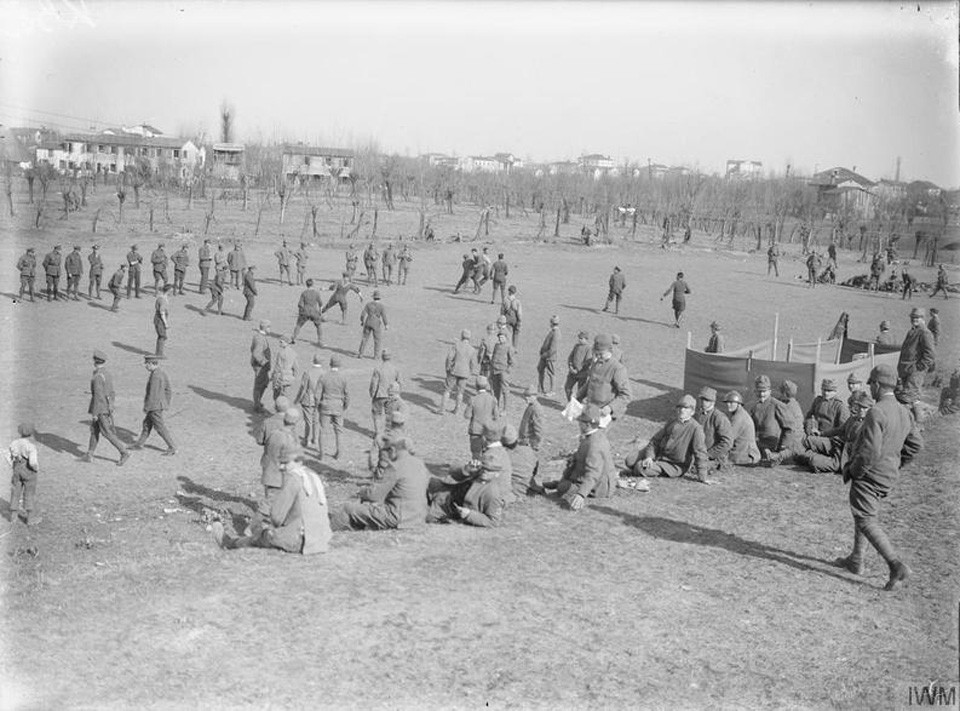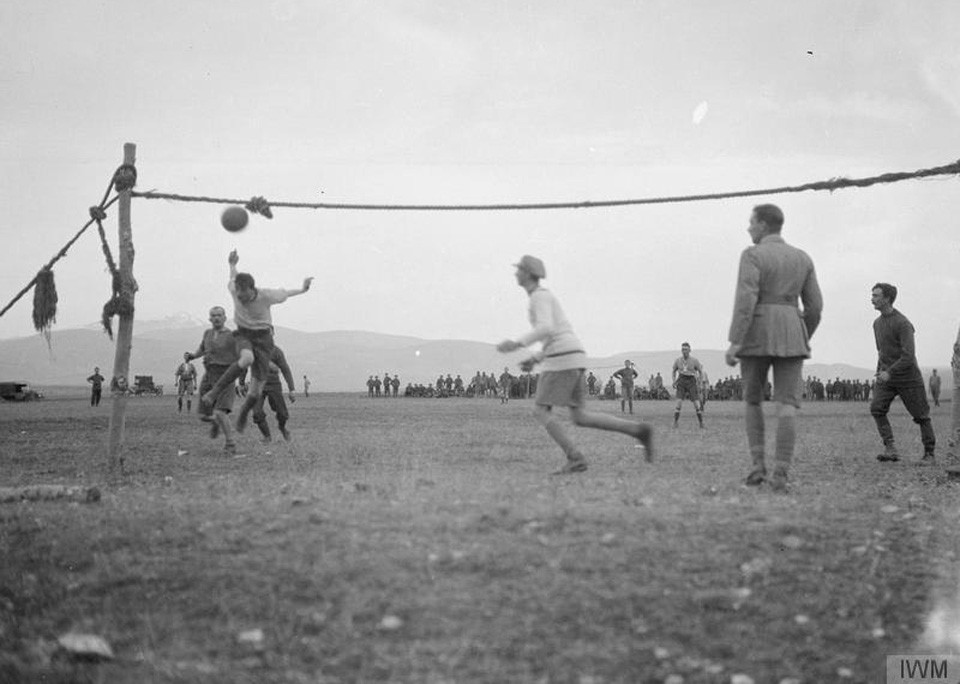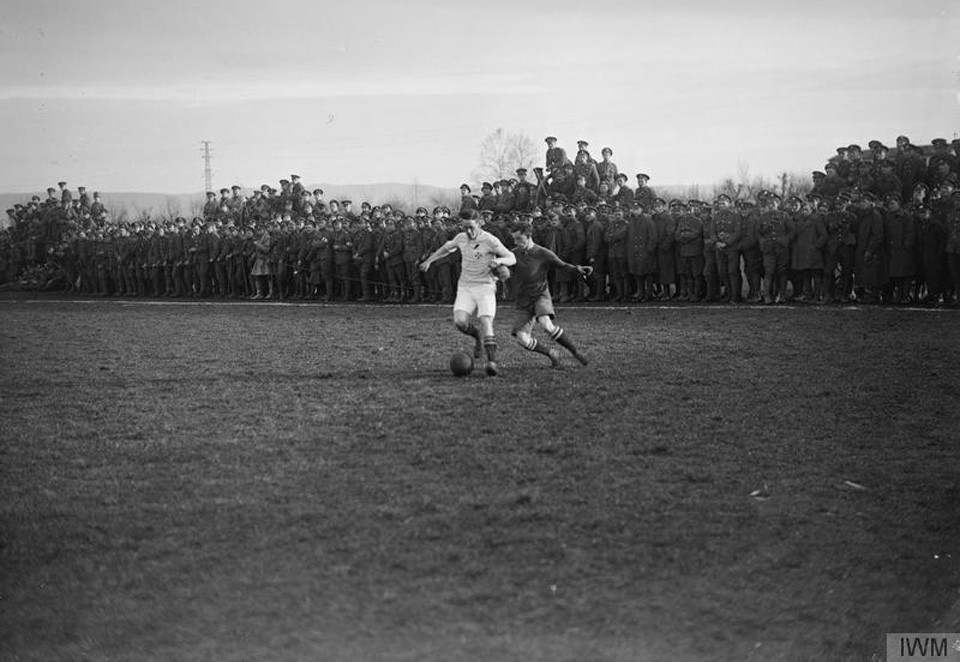Did England And Germany Play Football In The War? The answer is yes, although not in an official, organized sense. The most famous instance, the Christmas Truce of 1914 during World War I, saw spontaneous games of football (soccer) erupt between British and German soldiers on the Western Front. While the extent and specifics of these matches are debated by historians, the event remains a powerful symbol of humanity amidst the brutality of war.
This article explores the historical context surrounding the Christmas Truce and the role of football during World War I, examining the evidence for and against organized matches between English and German troops, and delving into the broader significance of the sport for soldiers on all sides of the conflict. At CAUHOI2025.UK.COM, we aim to provide you with well-researched, easily understandable answers to your questions. Explore further to discover the nuances of this fascinating historical event, including football during wartime, the Christmas Truce of 1914, and World War I history.
1. The Christmas Truce of 1914: A Moment of Peace
The Christmas Truce of 1914 stands as a remarkable and poignant event in the history of World War I. Occurring during the early months of the war, it involved a series of unofficial ceasefires along the Western Front, where British and German troops, exhausted and disillusioned by the horrors of trench warfare, temporarily laid down their arms to celebrate Christmas.
1.1. Spontaneous Ceasefires
These ceasefires were not centrally organized or mandated by high command, but rather emerged spontaneously from the trenches themselves. Soldiers on both sides, driven by a shared sense of humanity and a longing for peace, initiated contact with their enemies.
1.2. Interactions Between Troops
The interactions that followed were extraordinary. Soldiers ventured into No Man’s Land, the desolate and dangerous space between the opposing trenches, to exchange gifts, share food and drink, sing carols, and even bury their dead. The atmosphere was one of camaraderie and goodwill, a stark contrast to the brutal fighting that had defined the war. General Walter Congreve described the scene as “one of the most extraordinary sights anyone has ever seen.”
1.3. The Football Match Debate
The most enduring image of the Christmas Truce is the alleged football match between British and German soldiers. While accounts of such a match have captured the public imagination, historians continue to debate whether it actually occurred.
- Evidence For: Many firsthand accounts from soldiers mention some form of football or informal kicking around of a ball. These accounts suggest that while a formal, organized match may not have taken place, soldiers on both sides did engage in spontaneous games.
- Evidence Against: Some historians argue that there is a lack of concrete evidence, such as official reports or photographic documentation, to support the claim of a full-fledged football match. General Congreve’s letter, for example, doesn’t specifically mention a game.
Regardless of whether a formal match took place, the Christmas Truce itself is a powerful testament to the human spirit’s ability to transcend conflict and find common ground, even in the midst of war.
2. Football in the Trenches: A Distraction from War
Even beyond the Christmas Truce, football played a significant role in the lives of soldiers during World War I. The sport provided a much-needed distraction from the horrors of trench warfare, offering a sense of normalcy and camaraderie in the midst of unimaginable circumstances.
2.1. Organized Matches
While formal matches between British and German troops were rare (and likely limited to events like the Christmas Truce), football was frequently played within individual units and between Allied units.
2.2. Morale Booster
The Imperial War Museum notes that football was used as a recruitment tool and helped maintain morale among the troops. Regular matches provided a physical outlet for pent-up energy and stress, while also fostering teamwork and a sense of belonging.
2.3. Symbolic Significance
Grantland’s Brian Phillips suggests that the ubiquitous presence of footballs in wartime photos reveals a deeper meaning. He argues that football served as a way to mask the horror of war, creating a semblance of order and safety in a chaotic and brutal environment.
 An impromptu game of football kicks off between British and Italian troops, as others take some time out to rest on the hills and watch on in 1917. Photo courtesy of Imperial War Museum
An impromptu game of football kicks off between British and Italian troops, as others take some time out to rest on the hills and watch on in 1917. Photo courtesy of Imperial War Museum
An impromptu game of football kicks off between British and Italian troops, as others take some time out to rest on the hills and watch on in 1917. Photo courtesy of the Imperial War Museum, showcasing football as a morale booster.
3. The Reality of War: Beyond the Game
It is important to remember that the Christmas Truce and the role of football in the trenches, while uplifting, represent only a small fraction of the overall experience of World War I. The war was a brutal and devastating conflict that claimed the lives of millions of soldiers and civilians.
3.1. The Horrors of Trench Warfare
Trench warfare was characterized by unsanitary conditions, constant exposure to danger, and a high risk of death or injury. Soldiers lived in cramped, muddy trenches, often infested with rats and lice. They were subjected to relentless shelling, sniper fire, and the ever-present threat of enemy attacks.
3.2. The Psychological Impact
The psychological toll of the war was immense. Soldiers suffered from shell shock (now known as PTSD), anxiety, depression, and a host of other mental health issues. The constant exposure to death and destruction left many with deep and lasting scars.
3.3. Remembering the Sacrifice
While the Christmas Truce and the image of soldiers playing football offer a glimmer of hope and humanity, it is crucial to remember the immense suffering and sacrifice that characterized World War I.
4. Evidence and Firsthand Accounts
While the Christmas Truce is well-documented, the specifics of football matches remain debated. Examining available evidence provides a clearer picture.
4.1. General Congreve’s Letter
General Walter Congreve’s letter, while not mentioning a football match directly, vividly describes the scene of fraternization: “was swarming with men and officers of both sides, shaking hands and wishing each other a happy Christmas.” This illustrates the widespread desire for peace and connection.
4.2. Other Soldier Accounts
Many other soldiers wrote about informal games or kicking around a ball. These accounts, though anecdotal, support the idea that football contributed to the truce’s spirit.
4.3. Historian Perspectives
Historians like those at the Imperial War Museum continue to analyze these accounts, offering different interpretations of the events. Their research helps clarify what likely happened versus what became legend.
5. The Enduring Legacy of the Christmas Truce
Despite the debates surrounding the specifics of the football match, the Christmas Truce remains a powerful symbol of peace and humanity in the midst of war. The event has inspired numerous books, plays, and films, and continues to capture the imagination of people around the world.
5.1. Symbol of Hope
The Christmas Truce represents a moment when soldiers on opposing sides were able to see each other as human beings, rather than as enemies. It offers a glimmer of hope that even in the darkest of times, peace is possible.
5.2. Reminder of Shared Humanity
The event serves as a reminder of our shared humanity and the importance of empathy and understanding, even in the face of conflict.
5.3. Inspiration for Future Generations
The Christmas Truce continues to inspire future generations to work towards peace and reconciliation. It is a testament to the power of human connection and the enduring hope for a better world.
6. Exploring the Open University’s Photo Gallery
To commemorate the 100th anniversary of the Christmas Truce, the Open University curated a photo gallery from the Imperial War Museum’s archives. This gallery vividly illustrates the role football played in the lives of soldiers during World War I.
6.1. Visual Documentation
The photographs showcase soldiers playing football in various settings, from makeshift pitches in the trenches to organized matches behind the lines.
6.2. Impact on Morale
These images provide further evidence of the sport’s importance in maintaining morale and providing a sense of normalcy amidst the horrors of war.
6.3. Historical Context
The photo gallery offers valuable historical context, helping us to understand the daily lives of soldiers and the ways in which they sought to cope with the challenges they faced.
 1916. A handmade football net is setup by soldiers for an inter-company match on the Balkan Front on Christmas Day. Imperial War Museum via Open University
1916. A handmade football net is setup by soldiers for an inter-company match on the Balkan Front on Christmas Day. Imperial War Museum via Open University
A handmade football net is set up by soldiers for an inter-company match on the Balkan Front on Christmas Day in 1916. Image courtesy of the Imperial War Museum via Open University.
7. Football as a Metaphor: Hiding the Horror
Brian Phillips’s perspective on the role of football during World War I provides a thought-provoking analysis of the sport’s deeper significance. He suggests that football served as a way to hide the horror of war, creating a semblance of order and safety in a chaotic and brutal environment.
7.1. Distraction from Reality
Phillips argues that the presence of footballs in wartime photos represents an attempt to pretend that war is like a game, with rules and safety. This allows soldiers to avoid confronting the true reality of their situation.
7.2. Psychological Coping Mechanism
Football, in this context, becomes a psychological coping mechanism, allowing soldiers to maintain their sanity and hope in the face of unimaginable adversity.
7.3. The Irony of War
Phillips also points out the cruel irony of using football as a metaphor for war, given the inherent violence and destruction of the conflict. War, he argues, is ultimately a metaphor for nothingness.
8. Beyond England and Germany: The Global Game in Wartime
While the Christmas Truce often focuses on English and German troops, it’s important to remember that soldiers from many nations participated in World War I. Football was played by troops from across the globe, highlighting its universal appeal.
8.1. British and Italian Troops
Photos from the Italian Front show British and Italian troops engaging in impromptu football matches, demonstrating that the sport transcended national boundaries.
8.2. The Royal Flying Corps
Even the Royal Flying Corps had its football team, showcasing the sport’s popularity across different military branches.
8.3. The Third Army Trench Mortar School
The football team of the British Third Army Trench Mortar School provides another example of how the sport was integrated into military life.
9. The Fanshawe Cup: Organized Competition
Beyond casual games, organized football competitions also took place during World War I. The Fanshawe Cup, for example, was a formal tournament played by British Army units on the Italian Front.
9.1. Morale and Competition
These tournaments helped to boost morale and provide a sense of healthy competition among the troops.
9.2. Structure and Organization
The existence of the Fanshawe Cup demonstrates that football was not just a spontaneous activity, but also a structured and organized part of military life.
9.3. A Break from the Front Lines
Such events provided a welcome break from the harsh realities of the front lines.
 Final of the 48th Divisional Fanshawe Cup. The 1/7th Battalion Worcestershire Regiment versus 1/7th Battalion Royal Warwickshire Regiment. Two players tackle for the ball as soldiers scramble to get a view on the Italian Front, Trissino, Italy in 1918. Photo courtesy of Imperial War Museum
Final of the 48th Divisional Fanshawe Cup. The 1/7th Battalion Worcestershire Regiment versus 1/7th Battalion Royal Warwickshire Regiment. Two players tackle for the ball as soldiers scramble to get a view on the Italian Front, Trissino, Italy in 1918. Photo courtesy of Imperial War Museum
The final of the 48th Divisional Fanshawe Cup, showcasing organized football competitions during World War I. Image courtesy of the Imperial War Museum.
10. Conclusion: Football, War, and Humanity
The question of whether England and Germany played football in the war is complex. While the Christmas Truce of 1914 may or may not have involved a formal match, it undoubtedly saw soldiers from both sides engaging in spontaneous games and acts of camaraderie.
10.1. The Enduring Power of the Story
Regardless of the specifics, the story of the Christmas Truce and the role of football in World War I continues to resonate today.
10.2. A Symbol of Hope and Resilience
It serves as a powerful reminder of the human capacity for hope, resilience, and connection, even in the face of unimaginable adversity.
10.3. Continuing the Search for Understanding
By exploring the historical context and examining the evidence, we can gain a deeper understanding of this remarkable event and its enduring legacy.
FAQ: Football and World War I
Here are some frequently asked questions about football and its role during World War I:
- Did England and Germany play an official football match during World War I? No official, organized match between England and Germany occurred during the war, although spontaneous games may have happened.
- What was the Christmas Truce of 1914? It was a series of unofficial ceasefires along the Western Front where British and German soldiers celebrated Christmas together.
- Did a football match actually happen during the Christmas Truce? Historians debate the extent, but accounts suggest informal games occurred.
- Why was football important to soldiers during World War I? It provided a distraction from the horrors of war, boosted morale, and fostered camaraderie.
- Was football only played by English and German soldiers? No, soldiers from many nations, including British, Italian, and French troops, played football.
- How did football affect the morale of troops? It offered a sense of normalcy, a physical outlet, and a way to connect with comrades.
- Where can I find evidence of football being played during World War I? The Imperial War Museum and Open University have photo galleries and archives.
- What is the significance of the Fanshawe Cup? It was an organized football competition among British Army units on the Italian Front.
- How is the Christmas Truce remembered today? It’s a symbol of peace and shared humanity, inspiring books, plays, and films.
- What can we learn from the Christmas Truce? It reminds us of the importance of empathy, understanding, and the hope for peace.
Do you have more questions about historical events or other topics? Visit CAUHOI2025.UK.COM for reliable answers and expert insights.
Explore More at CAUHOI2025.UK.COM
At CAUHOI2025.UK.COM, we are dedicated to providing clear, concise, and thoroughly researched answers to your questions. Whether you’re curious about historical events like the Christmas Truce or seeking information on other topics, our team of experts is here to help.
Need More Information?
Do you have more questions about World War I, the Christmas Truce, or other historical events? Our website offers a wealth of information and resources. You can also submit your own questions and receive personalized answers from our team of experts.
Contact Us
For further inquiries or to learn more about our services, please visit our “Contact Us” page on CAUHOI2025.UK.COM. We are here to provide the reliable and accessible information you need. We are located at Equitable Life Building, 120 Broadway, New York, NY 10004, USA and can be reached by phone at +1 (800) 555-0199.
Visit CauHoi2025.UK.COM today and discover the answers you’ve been searching for! Find clarity, gain knowledge, and explore the world with us.